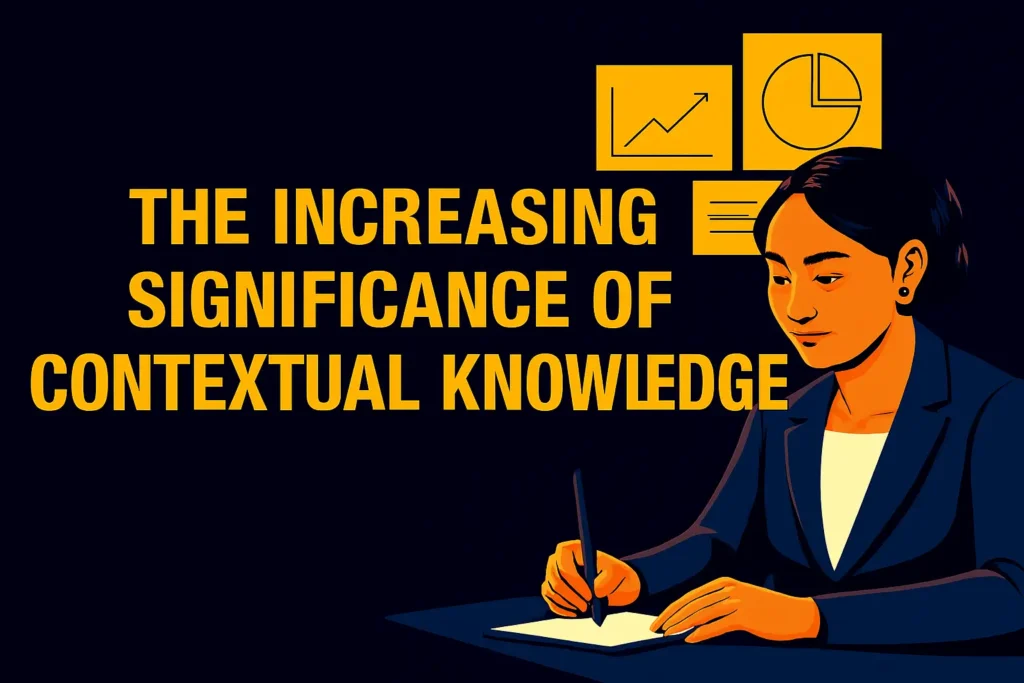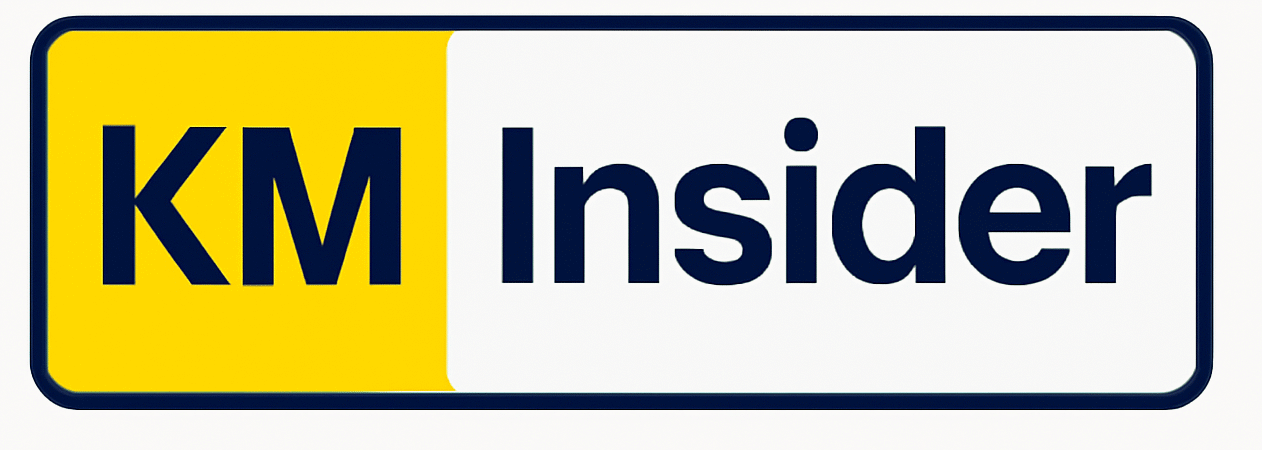In knowledge-intensive industries, from law and engineering to consulting and finance, the difference between information and knowledge is context. Contextual knowledge is the connective tissue that allows professionals and machines to make sense of information, apply it accurately, and generate new insights.

Contextual knowledge
Contextual knowledge is knowledge that is framed, interpreted, and applied within a specific situation or environment. It captures not just the what but the why and how — the reasoning behind decisions, the nuances of client relationships, and the organizational culture that shapes choices.
In their foundational paper Contextual Knowledge and Proceduralized Context, Brézillon and Pomerol (1999) describe three layers of context:
- External knowledge – general background that exists outside the current focus.
- Contextual knowledge – relevant background knowledge mobilized for understanding a situation.
- Proceduralized context – the portion of contextual knowledge applied to action and decision-making.
For instance:
- A project manager’s note on why a certain supplier was chosen.
- A lawyer’s reasoning behind how a precedent applies to a specific jurisdiction.
- A consultant’s insight into when to apply a certain framework.
These examples are contextual because they help others understand the application, not just content.
Why context matters for both people and AI
Technology alone does not guarantee that knowledge will flow. As Deloitte’s The New Knowledge Management report highlights, only nine percent of organizations feel truly ready to manage knowledge effectively, despite its ranking among the top three drivers of success. The reason is simple: while AI and platforms can store, tag, and retrieve, only people provide the meaning, context, and trust that turn information into actionable knowledge.
In knowledge-intensive industries, success depends not on how much knowledge is captured but on how meaningfully it is applied. Context ensures that both human and machine reasoning are grounded in relevance and that the right insight is applied at the right time, for the right purpose.
In AI-driven environments, context defines quality. Retrieval-Augmented Generation (RAG) and copilots depend on high-fidelity, context-rich sources. When the underlying knowledge is incomplete or lacks context, AI systems may exhibit reduced reliability and have difficulty determining accuracy or credibility.
Andrea Bencsik’s The Sixth Generation of Knowledge Management describes a new era where KM and AI work in symbiosis: AI augments our capacity to process and pattern data, while KM provides the framework that ensures that data is interpreted.
Ways to garner contextual knowledge
Capturing context is about understanding not only what people know, but how, when, and why they know it. It requires moving beyond static repositories toward dynamic, adaptive, and human-centered systems that can capture both tacit and explicit knowledge in the natural rhythm of work.
Technology alone does not ensure knowledge flow. True value arises when human intent and intelligent systems interact, when people are motivated to share and when technology supports that sharing seamlessly.
To achieve this, organizations need to design systems that embed knowledge capture into everyday processes, enrich it with context, and preserve the reasoning that gives it meaning. Below are a few examples of how to capture contextual knowledge:
Embed knowledge capture in the flow of work
The most effective knowledge capture happens as people work. According to Forrester’s Unlocking Efficiency report, organizations that automate capture within the flow of work see measurable gains in speed and accuracy of decision-making.
Capture insights as work happens through integrated tools like Microsoft Teams, Outlook, or project management systems. Notes from meetings, client feedback, and informal chats often contain critical contextual knowledge.
Enrich with metadata
Metadata is the backbone of contextual knowledge. It defines relationships, identifies authorship, and establishes the link between content and purpose. Yet Forrester found that manual tagging remains one of the greatest productivity barriers for knowledge workers.
Context emerges when information is linked to people, projects, or topics. Automatic metadata enrichment, combined with a structured review process and vector search capabilities, enables the application of context at scale, effectively transforming unstructured content into organized and meaningful knowledge.
Capture tacit knowledge before it walks out the door
Tacit knowledge is the intuition, experience, and reasoning of experts. Yet it remains the most difficult and valuable form of knowledge to capture. In professional services, construction, and engineering, it is often the difference between project success and failure.
AI transcription, summarization, and classification tools now make it possible to capture and codify these insights. Post-project reviews, mentoring sessions, and even informal storytelling can be transformed into searchable knowledge assets.
The key is to treat these conversations as strategic resources, not side activities. Encourage experts to narrate the reasoning behind their choices and use platforms that automatically capture and structure those narratives.
How to organize contextual knowledge
Organizing knowledge contextually means structuring it by meaning and relationship rather than by storage location. In a connected enterprise, knowledge must flow laterally across functions and vertically through strategy to form a network of insight.
Use taxonomies and ontologies. A robust enterprise taxonomy is the foundation of discoverability. Combined with AI-enabled ontologies, it allows organizations to connect related knowledge across departments, clients, and practice areas. This is not about a one size fit all approach because different teams need different entry points to shared knowledge. Ontologies ensure that connections are preserved even when structures evolve.
Apply metadata consistently. Consistency is what turns metadata into meaning. Without governance and validation, metadata becomes noise. Automated tagging supported by human curation allows organizations to maintain both scalability and accuracy. Forrester’s 2024 study found that advanced organizations use metadata not just for search but for insight generation, feeding analytics, Copilot prompts, and risk evaluation.
Preserve lineage and provenance. In the age of generative AI, it’s vital to know where knowledge originated and how it evolved. Knowing where knowledge originated, how it evolved, and who validated it is vital not only for compliance but also for maintaining trust.
How to share contextual knowledge
The future of knowledge management is participatory, contextual, and embedded in daily work. In this model, knowledge is not published once and forgotten; it is continuously shared, refined, and re-applied.
Deliver knowledge in context. Information should appear at the point of need. Whether drafting a proposal in Word or responding to a client query in Teams, the right template, policy, or insight should surface automatically. Atlas and other contextual delivery platforms match content to role, geography, and activity, ensuring relevance without search friction.
Encourage contribution. Deloitte’s research shows that organizations that prioritize knowledge transfer are seen by employees as more innovative, attractive, and competitive. Building such a culture requires visible recognition and reward for contribution.
Localize and personalize. Context differs by location and role. A compliance policy relevant in Frankfurt may not apply in Singapore. Modern systems must automatically localize and personalize information, filtering content by jurisdiction, language, and user profile. This not only enhances relevance but reduces risk of misapplication — a growing issue in global AI environment.
Balance automation with human oversight. Automation accelerates access but cannot replace human interpretation. Intelligent systems can surface the right insights; professionals ensure those insights are applied appropriately.
Contextual knowledge and future developments
As Andrea Bencsik’s research shows, the sixth generation of KM integrates cognitive computing into the knowledge process, enabling prediction, learning, and innovation that reflect both data and experience.
The next leap in KM will be about connection — linking what organizations already know into meaningful, explainable context that serves both people and AI.
Organizations that invest in contextual knowledge will gain faster decision-making, safer AI adoption, and a more empowered workforce.
Sources
Bencsik, A. (2021). The Sixth Generation of Knowledge Management. – The Headway of Artificial Intelligence. Journal of International Studies, 14(2), 84–101.
Brézillon, P. & Pomerol, J.-C. (1999). Contextual Knowledge and Proceduralized Context. AAAI Technical Report.
Deloitte Insights (2021). The New Knowledge Management: The Human Factor Activates the Collective Intelligence.
Forrester Consulting (2024). Unlocking Efficiency: The Inevitable Rise of Knowledge Work Automation.

